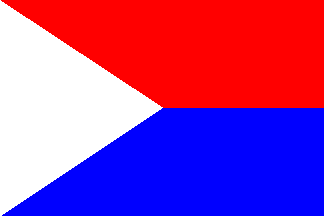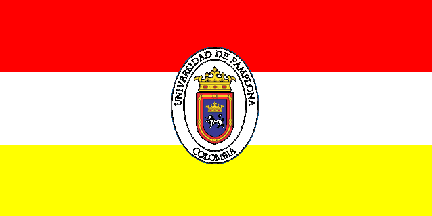
image by Ivan Sache, 27 January 2009

Last modified: 2009-08-15 by dov gutterman
Keywords: education |
Links: FOTW homepage |
search |
disclaimer and copyright |
write us |
mirrors
See Also:

image by Ivan Sache, 27 January 2009
"Colegio 'Pablo de Tarso'" (Paul of Tarsus) was
founded in January 1996 by the Federal District of Bogotá
(Decree No. 002).
The flag of the institute, as shown graphically on the website
of the institute, is horizontally divided red-blue with a
white triangle placed along the hoist.
Ivan Sache, 27 January 2009

image by Dov Gutterman, 21 July 2002
Image based on <www.unipamplona.edu.co>.
Dov Gutterman, 21 July 2002
Escuela de Enfermería
The Infirmary School of the Pedagogical and Technological
University of Colombia (Escuela de Enfermería Universidad
Pedaógica y Tecnológica de Colombia).
Flag at the university
website. The device ia sn oil lamp.
Jan Mertens, 2 December 2008
Actually, the translation of the name of this institution
should read 'School of Nursing of the Educational and
Technological University of Colombia.
Ron Lahav, 4 December 2008
"Fundación Gimnasio Pereira" is a girls' institute
located at Pereira, Department of Risaralda.
The institute was founded on 11 February 1947 by Arturo Vallejo,
Manuel Mejia, Manuel Uribe and Pablo Ramirez. After the death of
the first Director of the institute, Carlota Sánchez Marín, on
26 August 1958, the institute was transformed into a foundation
to avoid an economical crisis. The patron of the institute is St.
Thérèse of the Child Jesus.
The flag of the institute
was adopted after a competition won by Beatriz Toro (student in
1947-1957). The flag is beige with a red saltire and the coat of
arms of the institute in the middle. On the photo of the flag,
the coat of arms is tilted to the upper left corner (so that its
vertical axis is parallel to the descending diagonal of the
flag). The flag is 1.06 m x 2.40 m, the width of the arms of the
saltire being 10 cm.
Beige represents force, vigor and hope, while red represents
unity and love.
The flag shall be equipped with red tassels.
The first flag was made by the "RR. MM. Adoratrices" (I
guess, religious) of the town of Pereira.
The coat of arms of the institute was created by Jorge Roa
Martínez. The shield is vertically divided blue (for the
feminine grace, elegance and seriousness) and red (for love,
solidarity and social democracy) and crossed by a yellow bend
(for the precious gift of science and knowledge) charged with the
black letters "G" and "P" (for "Gimnasio
Pereira").
A white swan placed in the lower part of the blue field
represents the feminine grace; a white tower masoned black placed
in the upper part of the red field represents virtue.
The shield is surmonted by a white scroll charged with the motto
(in Spanish) "POR LA GRACIA Y LA VIRTUD" (For Grace and
Virtue).
Source: Institute
website
Ivan Sache, 13 April 2009
"Colegio Gimnasio Piedemonte" is located in
Bucaramanga.
The flag of the institute,
as shown graphically and described on the website
of the institute, is white with two thin diagonal stripes in
the lower left and upper right corners, blue and red,
respectively, and the emblem of the institute in the middle.
White symbolizes truth, justice and respect, as well as a open
mind to new and improved ideals and knowledge.
Blue symbolizes nature, source of life, and the commitment to
protect it through an intimate connivence with it and our
neighbour. Red recalls us love, energy and passion
required to study, teach, live and fullfill our mission in the
service of the society and of our country.
The emblem of the institute is circular and divided into four
equal parts. The upper left part is charged with a representation
of the earth, meaning that we should be prepared to be citizens
both of Colombia and of the world. The upper right part is
charged with the lamp of knowledge. The lower left part is
charged with a landscape, requiring the protection and
preservation of natural environment. The lower right parts is
charged with the five Olympic rings representing permanent
contact with sport.
The border of the emblem is charged with the white lettering
"GIMNASIO PIEDEMONTE / EXCELENTES".
Ivan Sache, 12 December 2009

image by Jairo Alonso Méndez Méndez, 7 October 2005
Corporación Universidad Piloto de Colombia - my university
(Bogotá, Distrito Capital and Girardot, Cundinamarca).
Jairo Alonso Méndez Méndez, 14 November 2004
I didn't have found any sources that confirms the flag and the
image is only a product of visual research in my university.
Jairo Alonso Méndez Méndez, 7 October 2005
"Instituto Técnico Industrial Piloto" (ITIPI) was
founded in 1939 in Bogotá as "Escuela Complementaria de
Espacializacion Artistica". Renamed "Instituto Popular
de Cultura" in 1949, the institute was given its current
name in 1954.
The flag of ITIPI, as shown graphically on the website
of the institute, is horizontally divided white-green with
the emblem of ITIPI in the middle.
The emblem of ITIPI is a white disk surrounded by a green ring
charged with "I.E.D. INSTITUTO TECNICO INDUSTRIAL PILOTO /
BOGOTA" in white letters and charged with a green device
presumably recalling the acronym of the institute and (my own
interpretation) a calliper rule.
Ivan Sache, 28 January 2009
"Escuela Normal Superior de Pitalito" was founded on
30 April 1950 in Pitalito, Department of Huila, succeeding
"Colegio San Antonio", founded in 1927.
A competition for the flag of the institute was organized in
1975, the year of the silver jubilee of the institute. The winner
was student Fernando Antonio Rincón Trujillo, who proposed a
flag with three equal, green-white-red stripes. Green represents
the valley of Laboyos. White represents the traditional
hospitality, generosity and good customs of the inhabitants of
the region. Red symbolizes the vitality and strength of the youth
studying at the institute. The arrangement of the stripes is,
unfortunately, not given.
Source: <www.colombiauniversal.com>.
Ivan Sache, 14 January 2009

image by Ivan Sache, 16 Febuary 2004
The Fundacion Universitaria de Popayan was established in 1982
in Popayan. The grounds of the foundation were destroyed by the
earthquake of 31 March 1983. New grounds were inaugurated on 1
August 1983. The Foundation manages a botanical garden dedicated
to biodiversity preservation, ethnobotany and germplasn
conservation. The garden is a membher of the national networks of
botanical gardens, prescribed by law #229 in 1996.
The flag of the FUP is horizontally divided in three equal
stripes, whose colours cannot be ascertained from the source
quoted below. For the attached image, I have selected a
grey-green upper stripe and a dark blue lower stripe, but these
shades need to be confirmed (or corrected).
Source: <www.fup.edu.co>,
located by Dov Gutterman.
Ivan Sache, 16 Febuary 2004
"Instituto Tecnológico del Putumayo" (ITP) was
created on 11 December 1989 (Law No. 65). ITP has its main seat
in the town of Mocoa and a secondary one in the town of Sibundoy.
The flag of ITP is shown
graphically and described on the ITP
website. The flag and the emblem of ITP were adopted after a
competition held at ITP and approved on 17 April 1996 (Decree No.
007). Designed by Luís Hernando Henao, the flag is rectangular,
divided into two equal parts by a rainbow. The upper left part is
sea blue while the lower part is green. The black letters
"ITP" are placed in the middle of the flag. There is a
small black border in the upper and lower parts of the flag.
The rainbow, also surrounding the emblem of ITP, represents the
biodiversity obtained from light in its brightest colours. Blue
represents the water resources of the region, green represents
the abundant vegetation and the black stripes the mineral
resources.
Detailed presentation of the symbols at <www.itp.edu.co>.
Ivan Sache, 19 December 2008